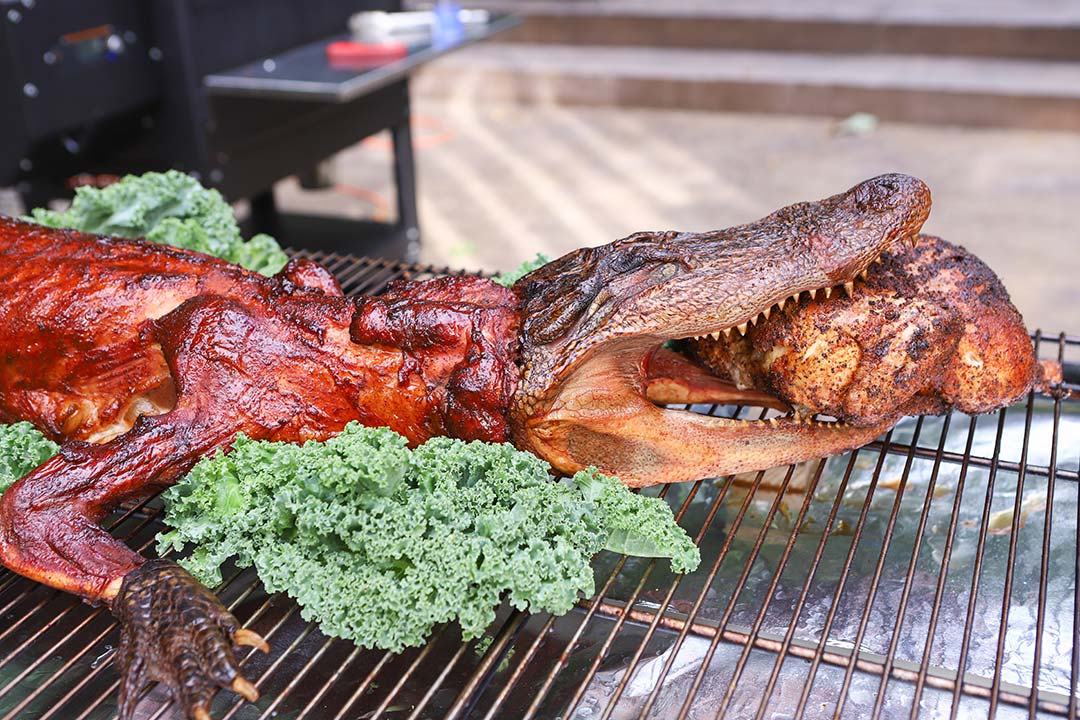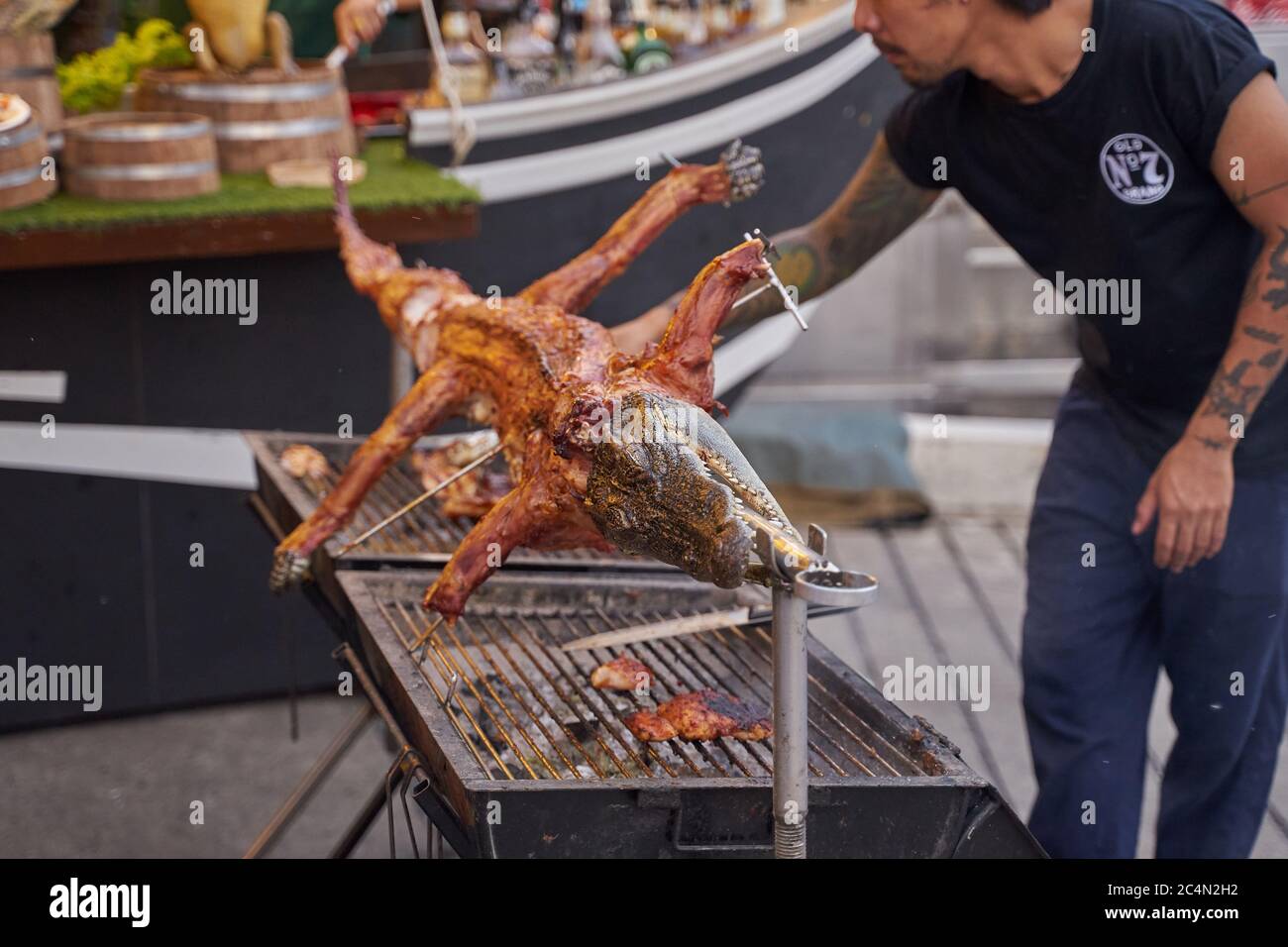
The Art of the Cook: Unlocking the Secrets of Crocodile Meat Cooking Times
Crocodile meat, once a rarity and often associated with adventurous culinary expeditions, is steadily making its way into mainstream cuisine. Its unique texture and subtle, gamey flavor profile offer a distinct departure from more common meats, presenting both a challenge and a reward for home cooks and professional chefs alike. However, a crucial element that often determines the success or failure of a crocodile dish lies in mastering its cooking time. Unlike familiar proteins, crocodile meat requires a nuanced understanding of heat and duration to achieve optimal tenderness and flavor.
The primary factor influencing crocodile meat cooking time is the cut of meat itself. Like beef or pork, different parts of the crocodile possess varying degrees of muscle fiber density and fat content, dictating how they respond to heat. The tail, for instance, is a lean and muscular section, akin to a firm fish fillet or a lean cut of venison. It requires careful attention to avoid drying out. The loin, on the other hand, is generally more tender and can tolerate slightly higher temperatures or longer cooking periods. Ribs and belly cuts, with their higher fat content, can be cooked more forgivingly, often benefiting from slow and low methods to render the fat and create a succulent result.
Another significant variable is the method of cooking. Grilling, pan-searing, and stir-frying are best suited for thinner, more tender cuts, where quick cooking times are paramount. These methods leverage high heat to create a beautiful sear, locking in moisture and developing flavor. Conversely, braising, stewing, and slow-cooking are ideal for tougher cuts or larger portions, allowing the connective tissues to break down, resulting in melt-in-your-mouth tenderness.

General Guidelines for Crocodile Meat Cooking Times:
While precise timings can vary, here are some general guidelines to help you navigate the cooking of crocodile meat:
-
Thin Cuts (e.g., tail medallions, loin steaks for quick searing):
- Pan-Searing/Grilling: Aim for 2-4 minutes per side over medium-high heat. The internal temperature should reach 140-145°F (60-63°C) for medium-rare, or 150-155°F (65-68°C) for medium. It’s crucial to avoid overcooking, as this will lead to a tough and dry texture.
- Stir-Frying: Cut into thin strips and cook for 2-3 minutes until just cooked through. High heat and constant movement are key to preventing overcooking.

-
Thicker Cuts (e.g., loin roasts, larger tail sections):
- Roasting: For a medium-rare roast, aim for an internal temperature of 135-140°F (57-60°C), which might take 15-20 minutes per pound at 350°F (175°C). For medium, aim for 145-150°F (63-65°C). Always allow for a resting period of 10-15 minutes after cooking.
- Braising/Stewing: These methods are far more forgiving. Tougher cuts can be simmered in liquid for 2-4 hours, or until fork-tender. The exact time will depend on the size of the cut and the heat of your liquid.
Factors Influencing Cooking Time:
Beyond the cut and cooking method, several other factors play a role:
- Thickness of the Meat: Thicker cuts will naturally require longer cooking times than thinner ones, regardless of the cut.
- Starting Temperature: Meat that is at room temperature will cook more evenly and slightly faster than meat straight from the refrigerator.
- Oven/Stove Temperature: Consistent and accurate temperature control is vital. An oven that runs hotter than its setting will cook meat faster, while a cooler oven will take longer.
- Marinades and Rubs: Acidic marinades can begin to "cook" the meat on a molecular level, potentially requiring slightly shorter cooking times. Similarly, rubs with sugar content can caramelize and burn quickly, necessitating careful monitoring.
- Doneness Preference: This is perhaps the most subjective factor. While general temperature guidelines exist, personal preference for how cooked you like your meat will ultimately dictate the final cooking time.
The Importance of Resting:
One of the most critical, yet often overlooked, steps in cooking any meat, including crocodile, is resting. After removing the meat from the heat, allow it to rest for at least 5-10 minutes (for smaller cuts) or 15-20 minutes (for larger roasts). During cooking, the muscle fibers contract, pushing moisture to the center. Resting allows these fibers to relax, redistributing the juices throughout the meat, resulting in a more succulent and flavorful final product. Cutting into the meat too soon will cause these precious juices to run out, leaving you with dry and less enjoyable crocodile.
Recognizing Doneness:
While a meat thermometer is the most reliable tool for gauging doneness, visual cues and touch tests can also be helpful:
- Color: Crocodile meat is typically pale pink to white when raw. As it cooks, it will turn opaque white. Overcooked meat will be uniformly dry and chalky white.
- Texture: Properly cooked crocodile meat should be tender and flake easily. Tough, rubbery texture is a sign of overcooking.
- Juices: When pierced with a fork or skewer, the juices should run clear, not pink or bloody.
Tips for Success:
- Source Quality Meat: As with any protein, the quality of your crocodile meat will significantly impact the final dish. Seek out reputable suppliers who ensure ethical sourcing and proper handling.
- Don’t Be Afraid of Marinades: Crocodile meat benefits greatly from marinades, which can tenderize and infuse flavor. Consider citrus-based marinades, soy sauce-based marinades, or even herb and spice rubs.
- Embrace Low and Slow for Tougher Cuts: For ribs, belly, or any particularly fibrous sections, invest time in braising or slow-cooking. The results will be incredibly rewarding.
- Monitor Closely: Because crocodile is lean, it can go from perfectly cooked to overcooked very quickly. Keep a close eye on your dish, especially during the final stages of cooking.
- Practice Makes Perfect: The more you cook crocodile meat, the more attuned you will become to its nuances and the more confident you will feel in your cooking times.
Recipe Ideas to Get You Started:
Here are a few recipe ideas that showcase different cooking methods and cuts of crocodile meat:
Recipe 1: Pan-Seared Crocodile Tail Medallions with Lemon-Garlic Butter
This recipe highlights the quick-cooking nature of crocodile tail, perfect for a weeknight meal.
Yields: 2 servings
Prep time: 10 minutes
Cook time: 6-8 minutes
Ingredients:
- 1 lb crocodile tail meat, trimmed and cut into 1-inch thick medallions
- 2 tablespoons olive oil
- 2 tablespoons unsalted butter
- 2 cloves garlic, minced
- 1 tablespoon fresh lemon juice
- 1 tablespoon fresh parsley, chopped
- Salt and freshly ground black pepper to taste
Instructions:
- Pat the crocodile medallions dry with paper towels. Season generously with salt and pepper.
- Heat olive oil in a large skillet over medium-high heat until shimmering.
- Carefully place the crocodile medallions in the hot skillet. Sear for 2-3 minutes per side, until golden brown and cooked through. The internal temperature should be around 145°F (63°C). Avoid overcrowding the pan; cook in batches if necessary.
- Remove the crocodile medallions from the skillet and set aside on a plate. Tent loosely with foil to rest.
- Reduce the heat to medium. Add the butter to the same skillet. Once melted, add the minced garlic and sauté for about 30 seconds until fragrant.
- Stir in the lemon juice and chopped parsley. Season with a pinch of salt and pepper.
- Return the crocodile medallions to the skillet and spoon the lemon-garlic butter sauce over them.
- Serve immediately, garnished with extra parsley if desired.
Recipe 2: Slow-Cooked Crocodile Ribs with BBQ Glaze
This recipe utilizes the slow-cooking method to tenderize the richer, fattier cuts of crocodile.
Yields: 4-6 servings
Prep time: 15 minutes
Cook time: 3-4 hours
Ingredients:
- 2-3 lbs crocodile ribs
- 1 tablespoon smoked paprika
- 1 teaspoon garlic powder
- 1 teaspoon onion powder
- 1/2 teaspoon cayenne pepper (optional)
- Salt and freshly ground black pepper to taste
- 1 cup your favorite BBQ sauce
- 1/4 cup honey
Instructions:
- Preheat your oven to 300°F (150°C) or set your slow cooker to low.
- In a small bowl, mix together the smoked paprika, garlic powder, onion powder, cayenne pepper (if using), salt, and pepper.
- Rub the spice mixture all over the crocodile ribs.
- For Oven Cooking: Place the ribs in a roasting pan and cover tightly with foil. Bake for 2.5 to 3 hours, or until the meat is starting to pull away from the bone.
- For Slow Cooker: Place the ribs in the slow cooker. Cook on low for 3-4 hours, or until tender.
- While the ribs are cooking, prepare the glaze. In a small saucepan, combine the BBQ sauce and honey. Heat gently over low heat, stirring until well combined and slightly thickened.
- Once the ribs are tender, remove them from the oven or slow cooker. Brush generously with the BBQ glaze.
- Increase the oven temperature to 400°F (200°C) or turn your slow cooker to high. Place the glazed ribs back in the oven (uncovered) or cook on high in the slow cooker for another 15-20 minutes, or until the glaze is caramelized and slightly sticky.
- Let the ribs rest for 5-10 minutes before serving.
Recipe 3: Crocodile Loin Stir-Fry with Mixed Vegetables
A quick and healthy way to enjoy crocodile loin, packed with flavor and vibrant vegetables.
Yields: 3-4 servings
Prep time: 15 minutes
Cook time: 8-10 minutes
Ingredients:
- 1 lb crocodile loin, thinly sliced against the grain
- 2 tablespoons soy sauce
- 1 tablespoon cornstarch
- 1 tablespoon sesame oil
- 1 tablespoon vegetable oil
- 1 red bell pepper, thinly sliced
- 1 yellow bell pepper, thinly sliced
- 1 broccoli crown, cut into florets
- 1 carrot, julienned
- 1/2 red onion, thinly sliced
- 2 cloves garlic, minced
- 1 inch ginger, grated
- For the Stir-Fry Sauce:
- 1/4 cup soy sauce
- 2 tablespoons oyster sauce
- 1 tablespoon rice vinegar
- 1 teaspoon sugar
- 1 teaspoon cornstarch
Instructions:
- In a medium bowl, combine the sliced crocodile loin with 2 tablespoons of soy sauce and 1 tablespoon of cornstarch. Toss to coat evenly and let marinate for at least 10 minutes.
- In a small bowl, whisk together all the ingredients for the stir-fry sauce until the cornstarch is dissolved. Set aside.
- Heat the vegetable oil and sesame oil in a large wok or skillet over high heat until shimmering.
- Add the marinated crocodile loin to the hot wok and stir-fry for 2-3 minutes, until browned and just cooked through. Remove the crocodile from the wok and set aside.
- Add the red bell pepper, yellow bell pepper, broccoli florets, julienned carrot, and red onion to the wok. Stir-fry for 3-4 minutes until the vegetables are tender-crisp.
- Add the minced garlic and grated ginger to the wok and stir-fry for another 30 seconds until fragrant.
- Pour the stir-fry sauce into the wok and stir until it thickens, about 1-2 minutes.
- Return the cooked crocodile to the wok and toss to coat with the sauce and vegetables.
- Serve immediately over steamed rice.
By understanding the intricacies of crocodile meat cooking times and experimenting with these versatile recipes, you can confidently explore the unique and delicious world of this remarkable protein. Embrace the challenge, and you’ll be rewarded with a truly memorable culinary experience.


